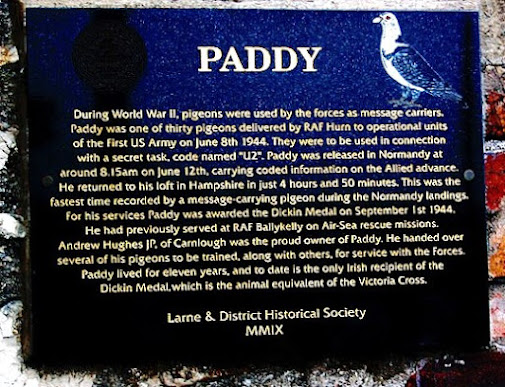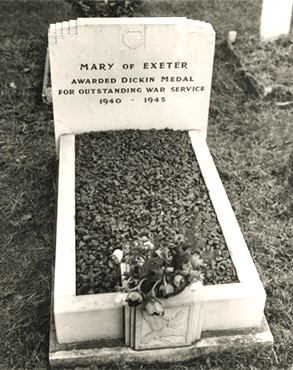Navy Blue wearing the Dickin Medal, March 1945
Image source
This year my blog posts for the April 2024 Challenge will be about the
recipients of the Dickin Medal, which you can read about here. They are
in alphabetical, not chronological order, within the different letters.
All the recipients in the ‘N’
category are pigeons, so a little more general information about pigeons might
be useful.
All homing pigeons are descended
from Columba livia, the Rock Dove, and were selectively bred to produce
the most efficient homing pigeons. In ancient times, the birds could only fly
about 100 miles a day, but modern birds can accomplish 600 to 700 miles daily,
without needing to stop for rest. They have a top speed of 60 mph, though
exceptionally, some can fly faster and further, particularly with a following
wind.
In Ancient Persia and Syria, in
the 5th century BC (BCE) messenger pigeons were used in a
sophisticated network for communication.
Around 3000 BCE, in Mesopotamia (modern
Iraq and Iran) and Egypt, pigeons were being domesticated and trained to
‘home’. In 2900 BCE, in Ancient Egypt, ships used pigeons to announce their
imminent arrival. In 2350 BCE, in what is now Iraq, the King ordained that each
messenger should carry a homing pigeon. In the event of capture, the messenger
would release the bird, which would fly back to the palace, thus indicating
that another messenger should be dispatched. In ancient Egypt, doves were
released as a way of announcing the reign of a new Pharaoh.
In Ancient Greece, pigeons
carried the names of victorious Olympians back to their cities, in addition to
relaying messages of battle victories.
Doves were released at the Olympics, from 1920
as part of the opening ceremony. Prior to that, they had been used in the
closing ceremony. However, in 1988, at the Seoul Games, many of the doves died
in the cauldron flames and the practice was discontinued. The Tokyo Games in
2021 released 1,000 paper doves.
Composed around 538 BCE, the Book of Genesis (8:vv
6-12) related how Noah dispatched a dove from the Ark to discover if the
flood had abated. The dove came back and was sent out again. Eventually, it
returned, carrying a twig from an olive tree, which proved to Noah that the
waters had begun to subside.
Rome had dovecotes that housed
more than 5000 pigeons and the Romans used messenger pigeons to support their
troops. Julius Caesar dispatched pigeons to convey messages in his conquest of
Gaul in 58 to 51 BCE.
During the 5th to 10th
centuries of the Dark Ages, the Arabs established regular pigeon services. One
caliph used pigeons to deliver cherries from Lebanon, each individual carrying
one cherry in a silken bag. The price for a prize pair of messenger pigeons could
reach one thousand gold pieces. Pigeon post was the most efficient and effective
means of communication throughout the Dark Ages and the Middle Ages.
During the Crusades, Richard the
Lionheart’s men intercepted a pigeon carrying a message that a Muslim relief army
was advancing to support the battle against the Christians at Ptolemais. The pigeon
was sent on its way with a false message that no help was forthcoming, so the
town surrendered and the Christians were firmly embedded by the time the relief
army arrived.
In the middle of the 19th
century, pigeons were used by the Reuters news agency in the transmission of
stock prices and news between Germany and Belgium. They were considered faster
than rail and more reliable than telegraph. In succeeding years, pigeon post
was developed by France, Prussia, Germany, Russia and Italy.
By the end of the 19th
century, Canada and USA were using pigeons for civilian and military purposes,
so that, when the First World War commenced, it was customary to rely on birds
for communication.
N
Navy Blue
In March 1945, Navy Blue was awarded the DM. This
bird was bred by the RAF and the citation read, ‘For
delivering an important message from a Raiding Party on the West Coast of
France, although injured, while serving with the RAF in June, 1944’.
NPS.42.NS.2780
This recipient was bred in Hereford by B. Powell, served
with the National Pigeon Service (Special Section) and received the DM in
October 1945, ‘For bringing important messages
three times from enemy occupied country, viz: July 1942, August 1942 and April
1942, while serving with the Special Service from the Continent.’
NPS.42.NS.7524
NPS.42.NS.7524 with the Dickin Medal, October 1945Image source
Bred in Barnsley by C. Dyson, and serving with the Special
Section of the NPS, the citation for this pigeon read, ‘For
bringing important messages three times from enemy-occupied country, viz: July
1942, May 1943 and July 1943, while serving with the Special Service from the continent.’
The award was made in October 1945.
NURP.38.BPC.6
NURP.38.BPC.6Image source
Bred in Somerset by S.J. Bryant, this pigeon was
honoured in August 1946, ‘For three outstanding
flights from France while serving with the Special Section, Army Pigeon Service,
11th July 1941, 9th September 1941, and 29th
November 1941.’
NURP.43.CC.1418
Awarded the DM in January, 1947, this bird was bred
by T. Markham in Kendal. It made the flight from Normandy in under 24 hours in
very poor weather conditions, after having been confined in a carrier for five
days. The citation was, ‘For the fastest flight
with message from 6th Airborne Div. Normandy, 7th June,
1944, while serving with the APS.’ Pigeon Post
White wing, white wing,
Lily of the air,
What word dost bring,
On whose errand fare?
Red word, red word,
Snowy plumes abhor.
I, Christ’s own bird,
Do the work of war.
By Katherine Lee Bates, 1859-1929.
(She wrote the words for ‘America the Beautiful’.)
My
thanks to ‘No Roots Sussex’, who gave me the link to 'The Warrior Birds Memorial in Beach House Park in Worthing' at https://www.southcoastview,co.uk/news/warrior-birds-memorial
At the beginning of the 1940s, Great Britain set up ‘Operation Columba’ in
order to send messages by pigeon. At
first, it relied on donated birds until a breeding programme was organised.
The birds faced many challenges – poor
visibility, strong headwinds, atrocious weather, attacks by birds of prey,
gunshot and shrapnel – and casualties were high.
All combatants were aware of the use of
pigeons to convey messages and it was considered entirely legitimate to shoot
them down. In Germany, unregistered breeders were regarded as traitors and many
hundreds were rounded up with their birds and shot.
Falcons were used by all sides, but
the birds of prey were unable to distinguish between allied pigeons and those
of the enemy. British falcons flew high and were able to
observe all the islands off the Cornish coast. Any pigeon venturing over the Isles
of Scilly would be targeted by falcons, which patrolled for two-hour shifts.










.webp)









